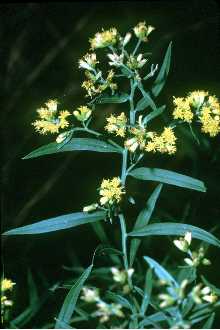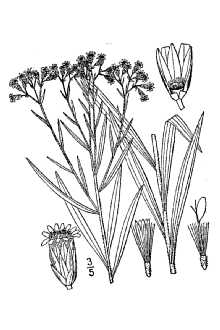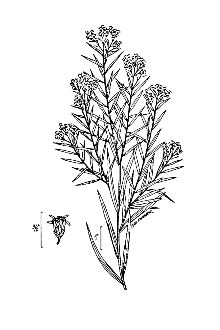Flat-top Goldentop
Scientific Name: Euthamia graminifolia (L.) Nutt.

| General Information | |
|---|---|
| Usda Symbol | EUGR5 |
| Group | Dicot |
| Life Cycle | Perennial |
| Growth Habits | Forb/herb |
| Native Locations | EUGR5 |
Plant Guide
Alternate Names
Common Alternate Names: bushy, common, fragrant, grass-leaved, or flat-topped goldenrod Scientific Alternate Names: Solidago graminifolia (L.) Salisb. Solidago lanceolata L. Chrysocoma graminifolia L.
Uses
Wildlife Use: Euthamia graminifolia provides a nectar source for pollinators and is well-suited for use in pollinator restoration. Preliminary observation found that flat-top goldentop attracted 13 different species of Hymenoptera and Lepidoptera in Cape May, New Jersey. The European honey bee (Apis mellifera), common buckeye (Junonia coenia), and eastern carpenter bee (Xylocopa virginica) were most frequently observed visiting the flower. The wildlife value of this species is considered low; nevertheless, songbirds such as the American goldfinch (Carduelis tristis) and the swamp sparrow (Melospiza georgiana) feed on the seeds (Hilty, 2002). Deer and rabbit enjoy browsing the plant. The flower attracts the goldenrod soldier beetle (Chauliognathus pensylvanicus) and black blister beetle (Epicauta pensylvanica). The goldenrod soldier beetle larvae are beneficial insects known to feed on aphids, maggots, caterpillars, and grasshopper eggs; while the adults help to pollinate plants (Trigg, 2005). Black blister beetles produce cantharidin, a poisonous substance that may poison animals that graze the plant (Marlin, n.d.). Please refer to Hilty (2002b) for a complete list of insects that visit this plant. Erosion Control: E. graminifolia can be used as a primary or secondary species for erosion control or vegetation cover.
Ethnobotany
Infusions with flower heads were used by the Forest Potawatomi to cure fevers, Leaves and oil have been used as a diuretic, diaphoretic, astringent, pulmonary aid, analgesic, and stimulant, It was used as a hunting medicine by the Ojibwa tribe (Great Lakes region) by smoking flowers to simulate the odor of a deer’s hoof, They also infused the flowers to relieve chest pain, The Chippewa used a decoction of the root to relieve lung trouble and chest pain, , Use soil moisture sensors to measure the soil moisture of Flat-top Goldentop.
Status
E. graminifolia is a native, facultative wetland plant that usually occurs in wetlands (67–99%) but is occasionally found in non-wetlands. Please consult the PLANTS Web site and your State Department of Natural Resources for this plant’s current status (e.g., threatened or endangered species, state noxious status, and wetland indicator values).
Description
General: E. graminifolia is an upright, erect, native perennial with a many-branched inflorescence. It is an herb of the Asteraceae family whose species name means “grass-leaf”. It grows to 3–6 ft in height with a 1–2 ft spread. The upper ½ of the plant appears bushy due to its branched stems and grass-like, narrow to linear, alternate leaves. It grows from a long-slender rhizome. The stalk-less 2–4 in long leaves taper to a long point, and narrow towards the stem. The leaf has 3–5 nerves underneath and is minutely rough-pubescent along nerves and margins. There are a few resinous dots on the underside of the leaf. The lower leaves are deciduous early in plant’s life cycle and the upper leaves are reduced towards the inflorescence. The leaves omit a scent when crushed. The primary stalk supporting the flower cluster is winged and pubescent with hairs lying flat on the wing margins. The flower heads are 2–2.5 in high, are arranged in dense, stalk-less, small, flat-topped clusters of 20–35 flowers. It has pale to bright yellow flowers that bloom in the late summer or early fall. The outer flowers of the cluster open first. The flower heads are cone-shaped and attached at the pointed end. The whorl of small leaves beneath the flower is ovoid to bell-shaped. The obtuse or rounded, yellow bracts around the flower are somewhat sticky. These overlapping bracts are 3.1 mm long and occasionally have green tips. The .5 mm long seed is a hard, pubescent, one-seeded, indehiscent white nutlet. The seed is attached to hair-like bristles (pappus). The receptacle is finely fringed. E. graminifolia var. graminifolia is distinguished by its relatively narrow leaves that are 11–20 times as long as wide (Gleason and Cronquist, 1963). E. graminifolia var. hirtipes is the hybrid of E. graminifolia and E. caroliniana (Fernald, 1950), and is distinguished by its relatively broad, hairy leaf blades and few-flowered head. Distribution: E. graminifolia can be found from New Brunswick to Saskatchewan, Alberta, Florida, Nebraska, and Wyoming. It is found in USDA Hardiness Zone 3–9. Its elevation ranges from 260–1427 ft. For current distribution, please consult the Plant Profile page for this species on the PLANTS Web site. Habitat: E. graminifolia can be found in moist, open ground; meadows; prairies; roadsides; ditches; inter-dunal flats; exposed lakes; conifer swamps; lowland forests; calcareous seeps; and sandy moist shorelines. It is tolerant of poor, gravelly, sandy, or dry soils and once established, can tolerate droughty conditions. It is also found in shaded wood edges or sunny fields and clearings. Generally, E. graminifolia is found in habitat that is noticeably wet, however it does grow in drier conditions, especially in old fields, were it may dominate. It is considered a ruderal species and can grow in strongly acidic to mildly alkaline conditions.
Establishment
Seed can be sown year-round in a greenhouse that is at least 65°F. The recommended planting is 3 seeds per 2 in plug, watered regularly. It can also be sown outdoors from seed in the fall or sown the seed in a coldframe. E. graminifolia is a prolific rhizomatous perennial that spreads aggressively through vegetative reproduction. When growing from vegetative material divide rootball (rhizomatous clumps) while plant is dormant. Cuttings should be kept in the greenhouse at least 3 months to allow for ample root and shoot development. When transplanted into field, plant on 1.5–2 foot centers. Unwanted seed dispersal from wind can be prevented by the development of a vegetative curtain or buffer with native shrubs, vines, or understory trees.
Management
Adding nitrogen will increase plant size, including an increase of stem height, number of leaves, and stem diameter. E. graminifolia seems to have a delayed response to nitrogen, and may store access N over winter in its rhizomes. Adding N has been shown to increase the density of stems in the second year after fertilization, thereby eliminating other plant species and reducing community diversity. Management of flat-top goldentop should consider the negative effect fertilization may have on existing community structure.
Pests and Potential Problems
Allelopathic chemical properties have been found in root and leaf extracts of E. graminifolia and may interfere with the growth of other species. Leaf leachates tend to interfere with seed germination while root leachates negatively affect the root growth of competing plants. Crops such as radish and lettuce are susceptible to allelopathic competition and should not be grown in the same area. Maples have also been negatively affected by similar Solidago species.
Environmental Concerns
Concerns
Concerns
Due to rhizomatous growth, E. graminifolia is somewhat aggressive. This plant may become a noxious weed so is perhaps not a good choice for more formal gardens unless controlled with a complimentary buffer planting. It is not as aggressive as S. Canadensis or S. rugosa. E. graminifolia is considered invasive in Europe.
Seeds and Plant Production
Plant Production
Plant Production
When collecting seed wait for all seeds to develop and dry on the plant because bloom is rotational and some seeds will be mature before others. Because the seeds are very tiny, it is more efficient to cut off the entire plant head. Dry collected seeds for 1–2 weeks in open paper bags or open bins. The seed is viable for up to 3 years in cold storage at 40˚F. For pre-planting, cold stratify seeds. There are 350,000 seeds/oz or 5.6 million seeds/ lb.
Fact Sheet
Alternative Names
Common Alternate Names: bushy, common, fragrant, grass-leaved, or flat-topped goldenrod Scientific Alternate Names: Solidago graminifolia (L.) Salisb. Solidago lanceolata L. Chrysocoma graminifolia L.
Uses
Wildlife Use:Flat-top goldentop provides a nectar source for pollinators and is well-suited for use in pollinator restoration. Preliminary observation found that flat-top goldentop attracted 13 different species of Hymenoptera and Lepidoptera in Cape May, New Jersey. The European honey bee (Apis mellifera),common buckeye (Junonia coenia), and eastern carpenter bee (Xylocopa virginica) were most frequently observed visiting the flower. The wildlife value of this species is considered low; nevertheless, songbirds such as the American goldfinch (Carduelis tristis) and the swamp sparrow (Melospiza georgiana) feed on the seeds (Hilty, 2002). Deer and rabbit enjoy browsing the plant. The flower attracts the goldenrod soldier beetle (Chauliognathus pensylvanicus) and black blister beetle (Epicauta pensylvanica). The goldenrod soldier beetle larvae are beneficial insects known to feed on aphids, maggots, caterpillars, and grasshopper eggs; while the adults help to pollinate plants (Trigg, 2005). Black b lister beetles produce cantharidin, a poisonous substance that may poison animals that graze the plant (Marlin, n.d.). Please refer to Hilty (2002b) fo r a complete list of insects that visit this plant.
Status
E. graminifolia is a native, facultative wetland plant that usually occurs in wet lands (67–99%) but is occasionally found in non-wetlands. Please consult the PLANTS Web site and your State Department of Natural Resources for this plant’s current status (e.g., threatened or endangered species, state noxious status, and wetland indicator values)
Weediness
This plant may become weedy or invasive in some regions or habitats and may displace desirable vegetation if not properly managed. Please consult with your local NRCS Field Office, Cooperative Extension Service office, state natural resource, or state agriculture department regarding its status and use. Weed informat ion is also available from the PLANTS Web site at http://plants.usda.gov. Please consult the Related Web Sites on the Plant Profile fo r this species for further informat ion.
Description and Adaptation
Adaptation
Adaptation
Description: Flat-top goldentop is an upright, erect, native perennial with a many-branched inflorescence, It is an herb of the Asteraceae family whose species name means “grass-leaf”, It grows to 3–6 ft in height with a 1–2 ft spread, The upper ½ of the plant appears bushy due to its branched stems and grass-like, narrow to linear, alternate leaves, It grows from a long-slender rhizome, Use soil moisture sensors to measure the soil moisture of Flat-top Goldentop., The stalk-less 2–4 in long leaves taper to a long point, and narrow towards the stem, The leaf has 3–5 nerves underneath and is minutely rough-pubescent along nerves and marg ins, There are a few resinous dots on the underside of the leaf, The lower leaves are deciduous early in plant’s life cycle and the upper leaves are reduced towards the inflorescence, The leaves omit a scent when crushed, The primary stalk supporting the flower cluster is winged and pubescent with hairs ly ing flat on the wing margins, The flower heads are 2–2,5 in high, are arranged in dense, stalk-less, small flat-topped clusters of 20–35 flowers with s mall rays, It has pale to bright yellow flowers that bloom in the late summer or early fall, The outer flowers of the cluster open first, The flower heads are cone-shaped and attached at the pointed end, The whorl of
Management
Adding nitrogen will increase plant size, including an increase of stem height, number of leaves, and stem diameter. E. graminifolia seems to have a delayed response to nitrogen, and may store access N over winter in its rhizomes. Adding N has been shown to increase the density of stems in the second year after fertilizat ion, thereby eliminating other plant species and reducing community diversity.
Pests and Potential Problems
Allelopathic chemical properties have been found in root and leaf ext racts of flat-top goldentop and may interfere with the growth of other species. Leaf leachates tend to interfere with seed germination while root leachates negatively affect the root growth of competing plants. Crops such as radish and lettuce are susceptible to allelopathic competition and should not be grown in the same area. Maples have also been negatively affected by similar Solidago species.
Environmental Concerns
Due to rhizomatous growth, E. graminifolia is somewhat aggressive. This plant may become a noxious weed so is perhaps not a good choice for more formal gardens unless controlled with a complimentary buffer planting. It is not as aggressive as S. Canadensis or S. rugosa. E. graminifolia is considered invasive in Europe.


